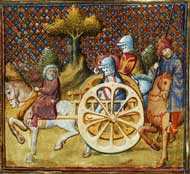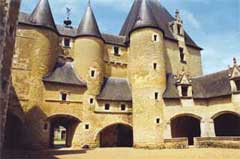Chrétien de Troyes
Chrétien de Troyes was the great author of the Arthurian cycle and one of the most important writers in French literature, both for the influence and the qualities of his style. He was born around 1135, and was one of the first novelists to write in French. He probably was born at Troyes, but this is not confirmed. What is certain is that he lived at Troyes, as his name implies. He wrote his novels between 1160 and 1183, and is considered the initiator of the modern novel.

The key scene from "The Knight of the Cart" by Chrétien de Troyes
Detail from a 14th century miniature
Chrétien de Troyes was well educated. His early works showed familiarity with the classics, being mostly adaptations and translations from Ovid and others. He was also familiar with the religious texts, Celtic legends, and the lyric poetry of courtly love. He attended two of the important courts of the time: that of Marie de Champagne, daughter of Louis VII and of Eleanor of Aquitaine, at her palaces in Troyes and Provins; then that of the Count of Flanders, Philip of Alsace. He also travelled in England. He died, according to Gaston Paris, when only about forty years of age, but most probably around 1183.
His major surviving poems are, besides a doubtful Guillaume d'Angleterre, the romances Erec and Enide, Cligès, Lancelot or the Chevalier de la Charrette (The Knight of the Cart), Yvain or the Chevalier au Lion (The Knight of the Lion), and Perceval, the Story of the Grail, left unfinished.
The troubadours of the 12th century came into existence in Provence, the lands of the Langue d’Oc. In the Northern part of France, their siblings, the trouvères were writing and singing in the Langue d’Oil. Under the influence of Marie of Champagne, they developed the troubadours’ motifs and the beautiful fiction of "courtly love," which made possible a great school of romantic poets.
It was Marie of Champagne who impressed these new ideas of courtly love upon Chrétien de Troyes. He introduced them into the Arthurian romances, the representatives par excellence of the courtly love ideal of 12th-century society. Chrétien himself tells us that his Chevalier de la Charrette, which reflects in an especial manner the concepts of courtly love, owes its existence to Marie of Champagne.
The ideas of love in the romances of Chrétien are indeed those found in the lyrics of the troubadours. But in many instances, his genius refined them using his particular style. The result of this process was the formulation of doctrines which became obligatory both for courtly lovers and for later writers who dealt with the subject. His contribution to the courtly system was the reinforcement of ideas already present in 12th century literature, the development of others, and the introduction of them all into the romances of the Round Table.
Chrétien de Troyes elaborately treated the three ideas imported from the troubadours of Provence: the idea that love is caused by the beauty of the opposite sex; the concept that through the eyes, beauty enters the heart, and inflicts a wound which only the lady can heal; and the one that, though absent from the loved one, the lover leaves his heart with her. Because of the subtle way in which Chrétien deals with these ideas, they may be regarded as his particular contribution to the system of the courtly love.
Chrétien de Troyes is distinctly a stylist. He composed works destined to be read at leisure rather than, like the chansons de geste, to be sung by the travelling minstrels. His language, even if monotonous to the modern reader, shows a desire to produce a definite effect through choice of expression. Chrétien plans the plot with the intention to keep curiosity awake. There is mystery in the development of his stories, and the hero's real name is long concealed. He is a psychologist in the study of emotion and the presentation of sentiments. Love becomes the subject of analysis and dissertation and passes into court gallantry, of which he is the chief representative in the literature of Northern France.
In his works, the expression of the love spirit varies, and increases as he goes on writing. Erec and Enide is a form of the Griselda story, about an innocent and persecuted wife. Cligès tells of the love of a youth and a maiden faithful to each other. She escapes at last by magic herbs which bring on a simulation of death, as in Romeo and Juliet. The Knight of the Cart or Lancelot (finished by another writer, Godefroy de Lagny) particularly shows the influence of the prevalent theories of love. The Chevalier au Lion resembles more the “roman d'aventures” in which a knight, after strange experiences, rescues a lady.
Chrétien de Troyes expresses the prevalent social ideals of chivalry; his hero behaves according to the rules of the courtly system and is ready to do largess or to perform brave deeds. Love is his main topic: he writes for women and is fond of describing beauty and its adornments.

